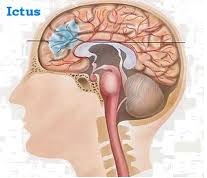Influence of secondary lesions on stroke
Keywords:
Cerebrovascular disorders, Stroke/complications/epidemiologyAbstract
Introduction: stroke is the most prevailing neurologic disease in patients admitted to Intensive Care Units, avoiding secondary lesions influencing on its evolution ensures higher survival rates.
Objective: to assess the influence of secondary lesions on the evolution of patients older than 18 years old suffering from strokes and admitted to No-3 Intensive Care Unit at Abel Santamaria Cuadrado University Hospital during September 2014-August 2015.
Method: a descriptive, retrospective, longitudinal cross-sectional study was conducted using the following variables: etiology, mortality, gender, skin color, risk factors, secondary lesions and hospital stay. The statistical analysis was carried out using chi-square test, odds ratio, absolute frequency and the mean value. The target group included 70 patients and the sample 38 having the pre-established inclusion criteria in the study.
Results: the incidence was low with 14.86%. Ischemic stroke prevailed and the mortality rate was higher for the hemorrhagic (76.47%), female gender and skin color constituted the predisposing factors to suffer from the cerebrovascular disease; the last one was statistically significant. Hypertension, smoking, ischemic heart disease and diabetes mellitus were reported as risk factors, whereas hypertension, hyperthermia, hypoxemia, cerebral edema and seizures accounted for secondary lesions. The 50% presented among 2-5 secondary lesions, the highest mortality rate was represented by those suffering from these lesions, and the first week of admission showed the greatest registers.
Conclusions: for an appropriate follow-up of hospitalized patients suffering from cerebro-vascular disease and in order to reduce the hospital stay and complications, secondary lesions should be avoided; which worsen the evolution and impede recovery.Downloads
References
1. Go AS, Mozaffarian D, Roger VL, Benjamin EJ, Berry JD et al. Heart disease and stroke statistics – 2013 update: A report from the American Heart Association. Circulation [Internet]. 2013 [citado 04 Jun 2015]; 127(1):e6–e245. Disponible en: http://circ.ahajournals.org/content/127/1/e6.long.
2. Mar J, Arrospide A, Begiristain JM, Larrañaga I, Elosegui E, Moreno JO. The impact of acquired brain damage in terms of epidemiology, economics and loss in quality of life. BMC Neurology [Internet]. 2011 [citado 04 Jun 2015]; 11:46-57. Disponible en: http://www.biomedcentral.com/1471-2377/11/46/
3. Donnan AG, Fischer M, Macleod M, David SM. Stroke. Lancet [Internet]. 2008 [citado 04 Jun 2015]; 371:162-23. Disponible en: http://www.karger.com/Article/Fulltext/131083
4. Roiz Balaguer M, Morales Barrab I. Mortalidad por enfermedad cerebrovascular en el Hospital Julio Trigo López 2012. Rev Haban Cienc Méd [Internet]. 2010 [citado 04 Jun 2015]; 9(1):. Disponible en: http://scielo.sld.cu/scielo.php?pid=S1729-519X2010000100005&script=sci_arttext
5. Rodríguez Lucci F, Pujol Lereis V, Ameriso S, Povedano G, Díaz MF, Hlavnicka A, et al. Mortalidad intrahospitalaria por accidente cerebrovascular. Medicina (Buenos Aires) [Internet]. 2013 [citado 20 Jul 2015]; 73(4):331-4. Disponible en: http://www.scielo.org.ar/scielo.php?pid=S0025-76802013000400006&script=sci_arttext&tlng=en
6. Bushnell C, Mccullough L, Awad, I. Guidelines for the Prevention of Stroke in Women. Stroke [Internet]. 2014 [citado 20 Jul 2015]; 45:000-000. Disponible en: https://stroke.ahajournals.org/content/45/5/1545.full
7. Ritzel R, Capozzi L, Mc Cullough L. Sex, Stroke, and inflammation: The potential for strogenmediated immunoprotection in stroke. Horm Behav [Internet]. 2013 [citado 20 Jul 2015]; 63(2):238-53. Disponible en: http://www.sciencedirect.com/science/article/pii/S0018506X12001146.
8. Cruz Flores S, Rabinstein A, Biller J, E Mitchell S.V, G Patrick, G Philip B, et al. Racial-Ethnic Disparities in Stroke Care: The American Experience. Stroke [Internet]. 2011 [citado 20 Jul 2015]; 42:2091-116. Disponible en: http://stroke.ahajournals.org/content/42/7/2091.short.
9. E González Casanova, R García Cabrera, M Rodríguez García Casariego. Factores de riesgo de las enfermedades cerebrovasculares en el municipio Ciego de Ávila. Mediciego [Internet]. 2013 [citado 20 Jul 2015]; 19 (1):. Disponible en: http://www.imbiomed.com.mx/1/1/articulos.php?method=showDetail&id_articulo=93192&id_seccion=3715&id_ejemplar=9130&id_revista=226
10. Kernan WN, Ovbiagele B, Black HR, Bravata DM, Chimowitz MI, Ezekowitz MD et al. Guidelines for the Prevention of Stroke in Patients With Stroke and Transient Ischemic Attack. Stroke [Internet]. 2014 [citado 20 Jul 2015]; 45:2160-2236. Disponible en: http://stroke.ahajournals.org/content/early/2014/04/30/STR.0000000000000024.full.pdf+html
11. Wrotek SE, Kozak WE, Hess DC, Fagan SC. Treatment of fever after stroke: conflicting evidence. Pharmacotherapy [Internet]. 2011 [citado 20 Jul 2015]; 31(11):1085–91. Disponible en: http://onlinelibrary.wiley.com/doi/10.1592/phco.31.11.1073/abstract

Published
How to Cite
Issue
Section
License
Authors who have publications with this journal agree to the following terms: Authors will retain their copyrights and grant the journal the right of first publication of their work, which will be publication of their work, which will be simultaneously subject to the Creative Commons Attribution License (CC-BY-NC 4.0) that allows third parties to share the work as long as its author and first publication in this journal are indicated.
Authors may adopt other non-exclusive license agreements for distribution of the published version of the work (e.g.: deposit it in an institutional telematic archive or publish it in a volume). Likewise, and according to the recommendations of the Medical Sciences Editorial (ECIMED), authors must declare in each article their contribution according to the CRediT taxonomy (contributor roles). This taxonomy includes 14 roles, which can be used to represent the tasks typically performed by contributors in scientific academic production. It should be consulted in monograph) whenever initial publication in this journal is indicated. Authors are allowed and encouraged to disseminate their work through the Internet (e.g., in institutional telematic archives or on their web page) before and during the submission process, which may produce interesting exchanges and increase citations of the published work. (See The effect of open access). https://casrai.org/credit/


